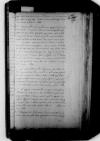List #5793
Alfonso de VALDÉS do Ioannes DANTISCUSs.l., [1526-09-18 — 1526-12-10 lub 1527-01-26 — 1527-03-30 lub 1527-10-18 — 1528-12-17 lub 1529-04-20 — 1529-07-27 lub 1529-08-12 — 1529-10-18 lub 1529-11-05 — 1530-04-18]
Regest polski: Valdes prosi Dantyszka o wyrozumiałość. Brak mu czasu na spotkania, gdyż codziennie musi być u kanclerza [Mercurino Gattinary]. Najlepszą porą po temu jest obiad, gdyż wieczorem niechętnie wychodzi z domu. Dlatego też dziś nie może przyjść na obiad do Dantyszka, ale jeśli będzie miał wolny czas, przyjdzie jutro. Obiecane listy do króla [Zygmunta I] i królowej [Bony] oraz paszport (litterae commeatus) cesarz prawdopodobnie podpisze nazajutrz. Valdes zatroszczył się, aby sporządzono dla Dantyszka kopie listów króla [Zygmunta I] i królowej [Bony] do cesarza. Zdaniem Valdesa wszyscy zawdzięczają tu tak wiele cnotom i zasługom Dantyszka, że nie ma potrzeby, aby wynagradzał on skrybę za przepisanie.
Rękopiśmienne podstawy źródłowe:
Pomocnicze podstawy źródłowe:
Publikacje:
| ||||||||||
Tekst + aparat krytyczny + komentarzZwykły tekstTekst + komentarzTekst + aparat krytyczny
Salutem.
Scias tu quidem, amice, quod meam negligentiam in meliorem partem interpretaris. Nihil certe mihi aut gratius, aut dulcius tua consuetudine esse posset. Cogor tamen semel in die convenire
ms 1 ... gap left by scribe⌈quaesoms 2 quaeso,
ms 1 ... gap left by scribe⌉, me excusa venturum cras ad prandium, si vacabit, nam hodie non licet nec possum. Ceterum omnes litterae tuae, tum ad
ms 1 nundum⌈nondumms 2 nondum,
ms 1 nundum⌉ tamen a
Vale.

 BK 222, No. 54, p. 200
BK 222, No. 54, p. 200